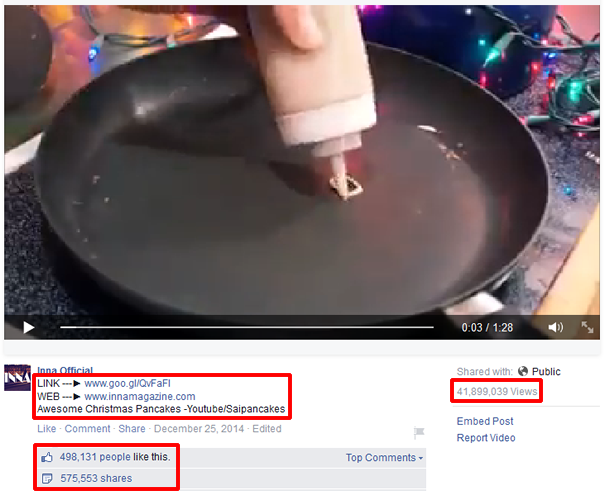Ripping Videos Off of YouTube + Uploading Them to Your Facebook Page = Amateur Garbage
 Uploading pirated “viral” videos to your Facebook page is not a smart way to increase your page’s reach. It may seem like a good idea, but in the end, it doesn’t really work. Unfortunately, far too many Facebook page managers believe that it does.
Uploading pirated “viral” videos to your Facebook page is not a smart way to increase your page’s reach. It may seem like a good idea, but in the end, it doesn’t really work. Unfortunately, far too many Facebook page managers believe that it does.
They see a cool video (usually on YouTube, but sometimes on Vine), and they download it from the site, using some third party software. Obviously, you can’t download a video from YouTube under normal circumstances. They use a tool or a browser add-on and rip the video that way. Then they upload the video to their Facebook page. Sometimes they provide some lame attribution; sometimes they don’t.
This isn’t a new problem. It’s been a constant in my Facebook news feed for several months. At pretty much any given time, I can visit Facebook and instantly pick out a pirated video. Mashable reported on the issue in August, as did The Daily Dot in October.
Who Does This?
You might think that the pages that do this are just random, unknown, low quality outfits without credibility. You would be at least partially correct. Most of them represent websites you’ve never heard of. Many of them are Buzzfeed wannabes, a group of unremarkable viral content clones that simply repurpose the creative works of others. Like Buzzfeed, they often trample over the rights of creators.
Some of these small pages have received a ton of likes and traffic due to this illicit content. One such person is James Ellis, who was so prolific in his infringement of copyrighted works that it garnered attention from Slate. SteamFeed’s post is a good read, as well. But if you step outside of cases like Mr. Ellis, and people like him, plenty of names you would recognize have engaged in this strategy. From well known websites to radio stations to major celebrities. They are being taken advantage of by unscrupulous practitioners.
Let me be clear: everyone who advocates this strategy is an amateur and should be looked at as such.
I suspect, following the attention Mr. Ellis’ gaming of the system received, Facebook did make some changes as far as news feed display. The volume of pirated video content in my feed has definitely gone down since then. That doesn’t mean that the uploading has stopped – just that it’s hitting my feed less. It is unclear if there was a consequence for Ellis, whose page is still online, with more than 1.5 million likes. He’s still posting videos he doesn’t own the rights to. Clearly, page managers are still seeing at least a superficial benefit from these activities.
Inna Official
I was reminded of this recently when the video below was shared by a Facebook friend of mine. I’m going to screenshot it as I want to point out a few things.

First, the surface-level metrics: 498,131 likes, 575,553 shares and 41,899,039 views! Most people reading this have never posted an update on Facebook that has reached that many people. I haven’t, either. And that’s why page managers are engaging in these tactics. Because it’s bringing people to their page. The more people interact with a page they have liked, the more likely that page is to show up in their personal news feed. If someone shares a video from Inna Official, they likely will see more updates from this page.
Facebook does bear some of the responsibility, and they need to do more. But that isn’t the point of this particular post. This is about Facebook page management and strategy.
Let’s talk about the dirty part of what Inna Official did. This is not a video they created. It was posted on the YouTube channel of Nathan Shields, who publishes these really cool pancake art videos under the name Saipancakes. Crazy fact: Mr. Shields’ own videos on YouTube have been viewed 4,853,099 times. All of his videos, combined. He has 63,443 subscribers. In other words, that one video on the Inna Official page has been viewed nearly 10 times as much as all of the videos on his YouTube channel have.
It’s debatable, but one could say that the Inna Official Facebook page has benefited more from Mr. Shields video than he has.
Let’s move to the bit of text that Inna Official has included in the video post. The third line of text is a very weak attempt at credit. No link. For the record, it wouldn’t matter if they had included a link to the video or to the Saipancakes website. You can’t rip off people’s videos and throw an attribution link their way and think you are good to go. It doesn’t work that way. Meanwhile, the second line of text is a link to the Inna Magazine website.
The Worst
I wanted to save the first line of text for last, because it’s the really good one. Where does the “LINK” go? Maybe to the original video? Nope, that would indicate a fraction of a conscience, which Inna Magazine does not have. The link goes to an article on their website where they (thankfully) embed his official video. Of course, that is pretty much worthless. His original video has been viewed 79,652 times. Again, their upload of his work has been viewed almost 42 million times.
That’s not all. We’re not done yet. In their article, scroll down and you will find pictures of the pancakes he made in the video. These pictures were taken by Mr. Shields and published on his website. Below the pictures there is a credit link. “Via: facebook.com.” Take a guess: where does “facebook.com” link to? Maybe to Mr. Shields’ Facebook page? Nope. Again, that assumes conscience. They link back to a different Facebook post that they made. This time, it’s a gallery of the photos from their article. They don’t even make a lame attempt at credit this time. Just links to their Facebook page, their website and a link back to the article on their website.
Oh yeah, one last note. In the screenshot, you’ll notice the video on Facebook is 1 minutes, 28 seconds. But Mr. Shields video, embedded below, is 1:49. What happened? They actually cut off the end of the video where he thanked people for subscribing to him. He explained that the popularity of his videos had enabled him to do some commissioned work that led to some great charitable donations. And they cut that off the end of the video. I can’t make this up.
Seriously, how big of a slimeball can you be?
Saipancakes
Speaking of Mr. Shields’ videos, I have seen them ripped off by random Facebook pages a ridiculous number of times. I mentioned the phenomena on my own Facebook profile in October. Quick searches using Facebook’s own search feature bring up numerous infringements of his work.
To be clear, I’m not saying Mr. Shields can’t capitalize and benefit, in some way, from the piracy. He can look at each infringement and make a conscious decision as to whether it benefits him to leave it alone – or if he wants to take action against it. There is a reason why he’s included the name of his brand at the start of the video, including the logos of the social media sites where he can be found (plus a watermark at various points throughout). Piracy happens and that’s one of the ways that you can negate the impact, ever so slightly. He’s converting a (very, very) small percentage of the people who are watching pirated copies of his videos.
Of course, plenty of people are doing the right thing and sharing responsibly and respectfully. Like 94.9 WOLX, who linked directly to his video. Or if you want to send people to an embed on your own website, that’s fine, too. Laughing Squid did this the right way. Their post includes not only the embed of his original video, but includes 1 link to his personal website, 1 link to his pancake website, 2 links to the actual holiday pancakes post on his site and 1 link to the video itself.
In other words: Laughing Squid is legit, respectable and worth your time. Inna Magazine is none of those things. Instead, they are a parasite.
Does This Strategy Really Work?
Personally, I could never do what these Facebook pages have done. I have to be able to look at myself in the mirror and, if I did this, I couldn’t. But let’s put aside the ethics and just look at it as a strategy. Is it worth it? The answer is still no.
As Mike Orren wrote, relevance matters. It matters a lot. Look back at James Ellis’ page. He has 1,552,235 likes as I write. The most recent post he has made that is relevant to his profession/what he’s selling, is a video. It was posted 12 hours ago. It has 69 likes, 5 shares and 3,888 views. Sound great? It shouldn’t. 69 likes and 5 shares in 12 hours from a collected base of 1,552,235 Facebook fans is abysmal.
He can rip off viral videos as much as he wants, but when he talks about something that is actually related to him, people tune out. And because they tune out, his updates become less and less likely to show up in the Facebook news feed of those who have liked his page. In other words, he fairly quickly loses the people he gained by ripping off all of those viral clips. The benefit is minimal because saying “I have 1.5 million Facebook fans!” is very cool, right up until you realize that only 4 of those fans will ever actually buy anything.
If all you want to be is a website that shares viral content, you might be able to make it work, for a while. You might even make a little money (expect low CPMs on your ads). But you’ll find an uphill battle when it comes to working with brands and organizations that value legitimacy. In other words, you’ll probably need to stay in your corner.
Finally, when you do this sort of thing, you increase your odds of losing your Facebook page. I’m not saying it will happen for sure. Clearly, Mr. Ellis is proof of this. But plenty of Facebook pages have been taken away due to repeated copyright violations. If your copyright is being violated on Facebook, you can find out how to report it here. If you need help doing so, please let me know.
Facebook has already made changes to help curb this behavior. They will continue to move in that direction. And that will probably lead to more pages being purged. Just like a lot of YouTube channels went away when YouTube became serious about copyright. The early days may seem lawless, but the early days come to an end.
If you truly believe that ripping off videos from other people is a worthwhile, beneficial strategy to grow a Facebook page, be prepared for a let down – and to have your page disappear.
